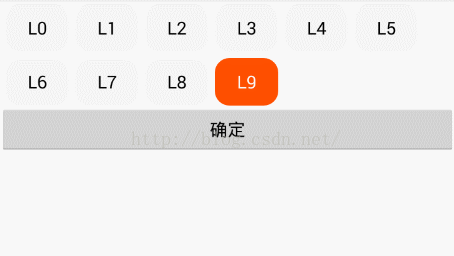话不多说,先上个效果图: 现在我们就来说说里面的一些原理把! 一、原理: 1.其实这里我们用到的是一个ViewGroup控件组,把这些按钮加进去就有这种效果了!不过这里要继承
话不多说,先上个效果图:

现在我们就来说说里面的一些原理把!
一、原理:
1.其实这里我们用到的是一个
ViewGroupViewGroupGoodsViewGroup2.主要的方法有:
GoodsViewGroup按钮组的控件大小
protected void onMeasure(int widthMeasureSpec, int heightMeasureSpec)里面的按钮每个的位置坐标
protected void onLayout(boolean changed, int l, int t, int r, int b) 这两个方法的具体使用大家可以网上查阅资料,这里就不多说了!
二、代码:
public class GoodsViewGroup<X extends TextView> extends ViewGroup {
public static final String BTN_MODE = "BTNMODE"; //按钮模式
public static final String TEV_MODE = "TEVMODE"; //文本模式
private static final String TAG = "IViewGroup";
private final int HorInterval = 10; //水平间隔
private final int VerInterval = 10; //垂直间隔
private int viewWidth; //控件的宽度
private int viewHeight; //控件的高度
private ArrayList<String> mTexts = new ArrayList<>();
private Context mContext;
private int textModePadding = 15;
//正常样式
private float itemTextSize = 18;
private int itemBGResNor = R.drawable.goods_item_btn_nORMal;
private int itemTextColorNor = Color.parseColor("#000000");
//选中的样式
private int itemBGResPre = R.drawable.goods_item_btn_selected;
private int itemTextColorPre = Color.parseColor("#ffffff");
public GoodsViewGroup(Context context) {
this(context, null);
}
public GoodsViewGroup(Context context, AttributeSet attrs) {
super(context, attrs);
mContext = context;
}
@Override
protected void onMeasure(int widthMeasureSpec, int heightMeasureSpec) {
super.onMeasure(widthMeasureSpec, heightMeasureSpec);
viewWidth = measureWidth(widthMeasureSpec);
viewHeight = measureHeight(heightMeasureSpec);
Log.e(TAG, "onMeasure:" + viewWidth + ":" + viewHeight);
// 计算自定义的ViewGroup中所有子控件的大小
measureChildren(widthMeasureSpec, heightMeasureSpec);
// 设置自定义的控件MyViewGroup的大小
setMeasuredDimension(viewWidth, getViewHeight());
}
private int measureWidth(int pWidthMeasureSpec) {
int result = 0;
int widthMode = MeasureSpec.getMode(pWidthMeasureSpec);
int widthSize = MeasureSpec.getSize(pWidthMeasureSpec);
switch (widthMode) {
case MeasureSpec.AT_MOST:
case MeasureSpec.EXACTLY:
result = widthSize;
break;
}
return result;
}
private int measureHeight(int pHeightMeasureSpec) {
int result = 0;
int heightMode = MeasureSpec.getMode(pHeightMeasureSpec);
int heightSize = MeasureSpec.getSize(pHeightMeasureSpec);
switch (heightMode) {
case MeasureSpec.UNSPECIFIED:
result = getSuggestedMinimumHeight();
break;
case MeasureSpec.AT_MOST:
case MeasureSpec.EXACTLY:
result = heightSize;
break;
}
return result;
}
@Override
protected void onLayout(boolean changed, int l, int t, int r, int b) {
// 遍历所有子视图
int posLeft = HorInterval;
int posTop = VerInterval;
int posRight;
int posBottom;
for (int i = 0; i < getChildCount(); i++) {
View childView = getChildAt(i);
// 获取在onMeasure中计算的视图尺寸
int measureHeight = childView.getMeasuredHeight();
int measuredWidth = childView.getMeasuredWidth();
if (posLeft + getNextHorLastPos(i) > viewWidth) {
posLeft = HorInterval;
posTop += (measureHeight + VerInterval);
}
posRight = posLeft + measuredWidth;
posBottom = posTop + measureHeight;
childView.layout(posLeft, posTop, posRight, posBottom);
posLeft += (measuredWidth + HorInterval);
}
}
//获取控件的自适应高度
private int getViewHeight() {
int viewwidth = HorInterval;
int viewheight = VerInterval;
if (getChildCount() > 0) {
viewheight = getChildAt(0).getMeasuredHeight() + VerInterval;
}
for (int i = 0; i < getChildCount(); i++) {
View childView = getChildAt(i);
// 获取在onMeasure中计算的视图尺寸
int measureHeight = childView.getMeasuredHeight();
int measuredWidth = childView.getMeasuredWidth();
if (viewwidth + getNextHorLastPos(i) > viewWidth) {
viewwidth = HorInterval;
viewheight += (measureHeight + VerInterval);
} else {
viewwidth += (measuredWidth + HorInterval);
}
}
return viewheight;
}
private int getNextHorLastPos(int i) {
return getChildAt(i).getMeasuredWidth() + HorInterval;
}
private OnGroupItemClickListener onGroupItemClickListener;
public void setGroupClickListener(OnGroupItemClickListener listener) {
onGroupItemClickListener = listener;
for (int i = 0; i < getChildCount(); i++) {
final X childView = (X) getChildAt(i);
final int itemPos = i;
childView.setOnClickListener(new OnClickListener() {
@Override
public void onClick(View view) {
onGroupItemClickListener.onGroupItemClick(itemPos);
chooseItemStyle(itemPos);
}
});
}
}
//选中那个的样式
public void chooseItemStyle(int pos) {
clearItemsStyle();
if (pos < getChildCount()) {
X childView = (X) getChildAt(pos);
childView.setBackgroundResource(itemBGResPre);
childView.setTextColor(itemTextColorPre);
setItemPadding(childView);
}
}
private void setItemPadding(X view) {
if (view instanceof Button) {
view.setPadding(textModePadding, 0, textModePadding, 0);
} else {
view.setPadding(textModePadding, textModePadding, textModePadding, textModePadding);
}
}
//清除Group所有的样式
private void clearItemsStyle() {
for (int i = 0; i < getChildCount(); i++) {
X childView = (X) getChildAt(i);
childView.setBackgroundResource(itemBGResNor);
childView.setTextColor(itemTextColorNor);
setItemPadding(childView);
}
}
public void addItemViews(ArrayList<String> texts, String mode) {
mTexts = texts;
removeAllViews();
for (String text : texts) {
addItemView(text, mode);
}
}
private void addItemView(String text, String mode) {
X childView = null;
switch (mode) {
case BTN_MODE:
childView = (X) new Button(mContext);
break;
case TEV_MODE:
childView = (X) new TextView(mContext);
break;
}
childView.setLayoutParams(new LayoutParams(LayoutParams.WRAP_CONTENT,
LayoutParams.WRAP_CONTENT));
childView.setTextSize(itemTextSize);
childView.setBackgroundResource(itemBGResNor);
setItemPadding(childView);
childView.setTextColor(itemTextColorNor);
childView.setText(text);
this.addView(childView);
}
public String getChooseText(int itemID) {
if (itemID >= 0) {
return mTexts.get(itemID);
}
return null;
}
public void setItemTextSize(float itemTextSize) {
this.itemTextSize = itemTextSize;
}
public void setItemBGResNor(int itemBGResNor) {
this.itemBGResNor = itemBGResNor;
}
public void setItemTextColorNor(int itemTextColorNor) {
this.itemTextColorNor = itemTextColorNor;
}
public void setItemBGResPre(int itemBGResPre) {
this.itemBGResPre = itemBGResPre;
}
public void setItemTextColorPre(int itemTextColorPre) {
this.itemTextColorPre = itemTextColorPre;
}
public interface OnGroupItemClickListener {
void onGroupItemClick(int item);
}
}上面提供了可以设置按钮组的item的一些样式,还有这个
GoodsViewGroupGoodsViewGroup<X extends TextView>ButtonTextViewButtonTextViewsetItemPadding(X view) 其实这里因为
TextViewpaddingbuttonpaddingTextViewpadding两种模式的写法:
1.Button :
GoodsViewGroup<Button> mGroup;
mGroup.addItemViews(viewtexts, GoodsViewGroup.BTN_MODE);2.TextView
GoodsViewGroup<TextView> mGroup;
mGroup.addItemViews(viewtexts, GoodsViewGroup.TEV_MODE);三、Drawable文件:上面涉及到的按钮选中与正常的两个Drawable
1.goods_item_btn_normal.xml
<?xml version="1.0" encoding="utf-8"?>
<layer-list xmlns:Android="Http://schemas.android.com/apk/res/android">
<item>
<shape>
<solid android:color="#F5F5F5" />
<corners android:radius="15.0dip" />
</shape>
</item>
</layer-list>2.goods_item_btn_selected.xml
<?xml version="1.0" encoding="utf-8"?>
<layer-list xmlns:android="http://schemas.android.com/apk/res/android">
<item>
<shape>
<solid android:color="#FE4F00" />
<corners android:radius="15.0dip" />
</shape>
</item>
</layer-list>四、例子:
ButtonGroupActivity
public class ButtonGroupActivity extends Activity implements GoodsViewGroup.OnGroupItemClickListener, View.OnClickListener {
private GoodsViewGroup<TextView> mGroup;
private Button mSubmitBtn;
private ArrayList<String> viewtexts = new ArrayList<>();
private int chooseID = -1;
private String chooseText;
@Override
protected void onCreate(Bundle savedInstanceState) {
setContentView(R.layout.activity_buttongroup);
mGroup = (GoodsViewGroup) findViewById(R.id.viewGroup);
mSubmitBtn = (Button) findViewById(R.id.submitBtn);
String text;
for (int i = 0; i < 10; i++) {
text = "L" + i;
viewtexts.add(text);
}
mGroup.addItemViews(viewtexts, GoodsViewGroup.TEV_MODE);
mGroup.setGroupClickListener(this);
mSubmitBtn.setOnClickListener(this);
super.onCreate(savedInstanceState);
}
@Override
public void onGroupItemClick(int item) {
chooseID = item;
chooseText = mGroup.getChooseText(item);
}
@Override
public void onClick(View view) {
if (chooseID >= 0) {
showToast("ID:" + chooseID + ";text:" + chooseText);
} else {
showToast("请选择");
}
}
private void showToast(String text) {
Toast.makeText(ButtonGroupActivity.this, text, Toast.LENGTH_SHORT).show();
}
}activity_buttongroup.xml
<?xml version="1.0" encoding="utf-8"?>
<LinearLayout xmlns:android="http://schemas.android.com/apk/res/android"
android:id="@+id/linear_ayout"
android:layout_width="match_parent"
android:layout_height="match_parent"
android:orientation="vertical">
<com.example.jisuanqi.GoodsViewGroup
android:id="@+id/viewGroup"
android:layout_width="match_parent"
android:layout_height="wrap_content">
</com.example.jisuanqi.GoodsViewGroup>
<Button
android:id="@+id/submitBtn"
android:text="确定"
android:layout_width="match_parent"
android:layout_height="wrap_content" />
</LinearLayout>总结
以上就是关于Android实现淘宝选中商品不同尺寸的按钮组的全部内容了,如果本文有什么问题欢迎大家指出,大家共同进步!希望本文对大家的学习和工作能有所帮助哦~
您可能感兴趣的文章:Android仿美团下拉菜单(商品选购)实例代码Android实现仿淘宝购物车增加和减少商品数量功能demo示例Android仿淘宝商品浏览界面图片滚动效果Android 仿淘宝、京东商品详情页向上拖动查看图文详情控件DEMO详解Android把商品添加到购物车的动画效果(贝塞尔曲线)Android自定义商品购买数量加减控件安卓(android)仿电商app商品详情页按钮浮动效果Android 仿京东、拼多多商品分类页的示例代码Android 仿淘宝商品属性标签页android仿京东商品属性筛选功能
--结束END--
本文标题: Android实现淘宝选中商品尺寸的按钮组实例
本文链接: https://lsjlt.com/news/24144.html(转载时请注明来源链接)
有问题或投稿请发送至: 邮箱/279061341@qq.com QQ/279061341
2024-01-21
2023-10-28
2023-10-28
2023-10-27
2023-10-27
2023-10-27
2023-10-27
回答
回答
回答
回答
回答
回答
回答
回答
回答
回答
0